Amine-Grafted Pomegranate Peels for the Simultaneous Removal of Nitrate and Phosphate Anions from Wastewater
Abstract
:1. Introduction
2. Materials and Methods
2.1. Preparation and Functionalization of Modified Pomegranate Peels
2.2. Preparation of Nitrate and Phosphate Solutions and Measurement of Their Concentration
2.3. Experiment of Isothermal Absorption
2.4. Characterization of Materials
2.4.1. FT-IR, XRD, and XPS Analysis
2.4.2. Zeta Potentials and Isoelectric Points
3. Results and Discussion
3.1. Study of the Adsorption Parameters
3.1.1. Effect of the pH
3.1.2. Effect of Adsorbent Dose
3.1.3. Temperature Effect
3.1.4. Effects of Initial Anion Concentration and Contact Time
3.1.5. Effect of the Co-Existing Ions
3.2. Performance of PP/AEAPTES: Bibliographic Comparison
3.3. Adsorption Isothinerms
3.4. Adsorption Thermodynamics
3.5. Adsorption Kinetics
3.6. Mechanism of NO3− and PO43− Adsorption onto PP/AEAPTES
3.7. Field Tests
3.8. Adsorption/Desorption Cycles
4. Conclusions
Supplementary Materials
Author Contributions
Funding
Institutional Review Board Statement
Informed Consent Statement
Data Availability Statement
Conflicts of Interest
References
- Ma, L.; Hu, L.; Feng, X.; Wang, S. Nitrate and Nitrite in Health and Disease. Aging Dis. 2018, 9, 938–945. [Google Scholar] [CrossRef] [PubMed]
- Hosseini, F.; Majdi, M.; Naghshi, S.; Sheikhhossein, F.; Djafarian, K.; Shab-Bidar, S. Nitrate-nitrite exposure through drinking water and diet and risk of colorectal cancer: A systematic review and meta-analysis of observational studies. Clin. Nutr. 2021, 40, 3073–3081. [Google Scholar] [CrossRef] [PubMed]
- Schindler, D.W.; Carpenter, S.R.; Chapra, S.C.; Hecky, R.E.; Orihel, D.M. Reducing Phosphorus to Curb Lake Eutrophication is a Success. Environ. Sci. Technol. 2016, 50, 8923–8929. [Google Scholar] [CrossRef] [PubMed]
- Zhan, Q.; Stratmann, C.N.; van der Geest, H.G.; Veraart, A.J.; Brenzinger, K.; Lürling, M.; de Senerpont Domis, L.N. Effectiveness of phosphorus control under extreme heatwaves: Implications for sediment nutrient releases and greenhouse gas emissions. Biogeochemistry 2021, 156, 421–436. [Google Scholar] [CrossRef]
- WHO. Guidelines Values for Chemicals that are of Health Significance in Drinking. In Guidelines for Drinking Water Quality, 3rd ed.; World Health Organization: Geneva, Switzerland, 2008. [Google Scholar]
- Wang, Y.; Yuan, S.; Liu, S.; Li, F.; Zhou, Z. Removal efficacy and mechanism of nitrogen and phosphorus by biological aluminum-based P-inactivation agent (BA-PIA). J. Environ. Sci. 2023, 127, 187–196. [Google Scholar] [CrossRef] [PubMed]
- Hu, T.; Wei, J.; Du, L.; Chen, J.; Zhang, J. The effect of biochar on nitrogen availability and bacterial community in farmland. Ann. Microbiol. 2023, 73, 4. [Google Scholar] [CrossRef]
- Dey, S.; Kumar, H.; Sinha, S.K.; Goud, V.V.; Das, S. Bacterial biofilm-based nitrate and phosphate removal from rubber latex wastewater for sustainable water usage. Water Environ. J. 2020, 34, 170–182. [Google Scholar] [CrossRef]
- Delgadillo-Mirquez, L.; Lopes, F.; Taidi, B.; Pareau, D. Nitrogen and phosphate removal from wastewater with a mixed microalgae and bacteria culture. Biotech. Rep. 2016, 11, 18–26. [Google Scholar] [CrossRef]
- Xu, J.; Pu, Y.; Qi, W.-K.; Yang, X.J.; Tang, Y.; Wan, P.; Fisher, A. Chemical removal of nitrate from water by aluminum-iron alloys. Chemosphere 2017, 166, 197–202. [Google Scholar] [CrossRef]
- Monea, M.C.; Löhr, D.K.; Meyer, C.; Preyl, V.; Xiao, J.; Steinmetz, H.; Schönberger, H.; Drenkova-Tuhtan, A. Comparing the leaching behavior of phosphorus, aluminum and iron from post-precipitated tertiary sludge and anaerobically digested sewage sludge aiming at phosphorus recovery. J. Clean. Prod. 2020, 247, 119129. [Google Scholar] [CrossRef]
- Huang, S.; Huang, H.; Zhu, H. Effects of the addition of iron and aluminum salt on phosphorus adsorption in wetland sediment. Environ. Sci. Pollut. Res. 2016, 23, 10022–10027. [Google Scholar] [CrossRef] [PubMed]
- Wang, X.; Phillips, B.L.; Boily, J.-F.; Hu, Y.; Hu, Z.; Yang, P.; Feng, X.; Xu, W.; Zhu, M. Phosphate sorption speciation and precipitation mechanisms on amorphous aluminum hydroxide. Soil Syst. 2019, 3, 20. [Google Scholar] [CrossRef]
- Hao, Z.; Xu, X.; Jin, J.; He, P.; Liu, Y.; Wang, D. Simultaneous removal of nitrate and heavy metals by iron metal. J. Zhejiang Univ. Sci. B 2005, 6, 307–310. [Google Scholar] [CrossRef] [PubMed]
- Ma, J.; Yao, H.; Yu, H.; Zuo, L.; Li, H.; Ma, J.; Li, X. Hydrazine addition enhances the nitrogen removal capacity in an anaerobic ammonium oxidation system through accelerating ammonium and nitrite degradation and reducing nitrate production. Chem. Eng. J. 2018, 335, 401–408. [Google Scholar] [CrossRef]
- Tan, L.; Mao, R.; Su, P.; Gu, J.; Chen, H.; Jiang, F.; Zhao, X. Efficient photochemical denitrification by UV/sulfite system: Mechanism and applications. J. Hazard. Mater. 2021, 418, 126448. [Google Scholar] [CrossRef]
- Bunce, J.T.; Ndam, E.; Ofiteru, I.D.; Moore, A.; Graham, D.W. A review of phosphorus removal technologies and their applicability to small-scale domestic wastewater treatment systems. Front. Environ. Sci. 2018, 6, 8. [Google Scholar] [CrossRef]
- Usman, M.O.; Aturagaba, G.; Ntale, M.; Nyakairu, G.W. A review of adsorption techniques for removal of phosphates from wastewater. Water Sci. Technol. 2022, 86, 3113–3132. [Google Scholar] [CrossRef]
- Song, N.; Xu, J.; Cao, Y.; Xia, F.; Zhai, J.; Ai, H.; Shi, D.; Gu, L.; He, Q. Chemical removal and selectivity reduction of nitrate from water by (nano) zero-valent iron/activated carbon micro-electrolysis. Chemosphere 2020, 248, 125986. [Google Scholar] [CrossRef]
- Sleiman, N.; Deluchat, V.; Wazne, M.; Mallet, M.; Courtin-Nomade, A.; Kazpard, V.; Baudu, M. Phosphate removal from aqueous solutions using zero valent iron (ZVI): Influence of solution composition and ZVI aging. Colloids Surf. Physicochem. Eng. Asp. 2017, 514, 1–10. [Google Scholar] [CrossRef]
- Maamoun, I.; Eljamal, R.; Falyouna, O.; Bensaida, K.; Sugihara, Y.; Eljamal, O. Insights into kinetics, isotherms, and thermodynamics of phosphorus sorption onto nanoscale zero-valent iron. J. Mol. Liq. 2021, 328, 115402. [Google Scholar] [CrossRef]
- Gibert, O.; Abenza, M.; Reig, M.; Vecino, X.; Sánchez, D.; Arnaldos, M.; Cortina, J.L. Removal of nitrate from groundwater by nano-scale zero-valent iron injection pulses in continuous-flow packed soil columns. Sci. Total Environ. 2022, 810, 152300. [Google Scholar] [CrossRef] [PubMed]
- Liu, Y.; Wang, J. Reduction of nitrate by zero valent iron (ZVI)-based materials: A review. Sci. Total Environ. 2019, 671, 388–403. [Google Scholar] [CrossRef] [PubMed]
- Dong, K.; Feng, X.; Yao, Y.; Zhu, Z.; Lin, H.; Zhang, X.; Wang, D.; Li, H. Nitrogen removal from nitrate-containing wastewaters in hydrogen-based membrane biofilm reactors via hydrogen autotrophic denitrification: Biofilm structure, microbial community and optimization strategies. Front. Microbiol. 2022, 13, 924084. [Google Scholar] [CrossRef] [PubMed]
- Chen, D.; Yang, K.; Wang, H.; Lv, B. Nitrate removal from groundwater by hydrogen-fed autotrophic denitrification in a bio-ceramsite reactor. Water Sci. Technol. 2014, 69, 2417–2422. [Google Scholar] [CrossRef] [PubMed]
- Siwek, H.; Bartkowiak, A.; Włodarczyk, M.; Sobecka, K. Removal of phosphate from aqueous solution using alginate/iron (III) chloride capsules: A laboratory study. Water Air Soil Pollut. 2016, 227, 427. [Google Scholar] [CrossRef]
- Gizaw, A.; Zewge, F.; Kumar, A.; Mekonnen, A.; Tesfaye, M. A comprehensive review on nitrate and phosphate removal and recovery from aqueous solutions by adsorption. AQUA Water Infrastruct. Ecosyst. Soc. 2021, 70, 921–947. [Google Scholar] [CrossRef]
- Yang, W.; Wang, J.; Shi, X.; Tang, H.; Wang, X.; Wang, S.; Zhang, W.; Lu, J. Preferential nitrate removal from water using a new recyclable polystyrene adsorbent functionalized with triethylamine groups. Ind. Eng. Chem. Res. 2020, 59, 5194–5201. [Google Scholar] [CrossRef]
- Zhang, M.; Song, G.; Gelardi, D.L.; Huang, L.; Khan, E.; Mašek, O.; Parikh, S.J.; Ok, Y.S. Evaluating biochar and its modifications for the removal of ammonium, nitrate, and phosphate in water. Water Res. 2020, 186, 116303. [Google Scholar] [CrossRef]
- Yin, Q.; Zhang, B.; Wang, R.; Zhao, Z. Biochar as an adsorbent for inorganic nitrogen and phosphorus removal from water: A review. Environ. Sci. Pollut. Res. 2017, 24, 26297–26309. [Google Scholar] [CrossRef]
- Wang, L.; Liu, S.; Xuan, W.; Li, S.; Wei, A. Efficient Nitrate Adsorption from Groundwater by Biochar-Supported Al-Substituted Goethite. Sustainability 2022, 14, 7824. [Google Scholar] [CrossRef]
- Almanassra, I.W.; Mckay, G.; Kochkodan, V.; Atieh, M.A.; Al-Ansari, T. A state of the art review on phosphate removal from water by biochars. Chem. Eng. J. 2021, 409, 128211. [Google Scholar] [CrossRef]
- Lazaratou, C.V.; Vayenas, D.V.; Papoulis, D. The role of clays, clay minerals, and clay-based materials for nitrate removal from water systems: A review. Appl. Clay Sci. 2020, 185, 105377. [Google Scholar] [CrossRef]
- Rezvani, P.; Taghizadeh, M.M. On using clay and nanoclay ceramic granules in reducing lead, arsenic, nitrate, and turbidity from water. Appl. Water Sci. 2018, 8, 131. [Google Scholar] [CrossRef]
- Jung, J.; Choi, M.; Police, A.K.R.; Lee, J.; Bae, S. Removal of Phosphorus by Ferric Ion-Rich Solutions Prepared Using Various Fe(III)-Containing Minerals. Water 2022, 14, 3765. [Google Scholar] [CrossRef]
- Isaad, J.; El Achari, A. Preparation of aminated magnetite/SiO2/chitosan core-shell nanoparticles for efficient adsorption of nitrate and phosphate anions in water. Int. J. Environ. Anal. Chem. 2021, 1–30. [Google Scholar] [CrossRef]
- Karthikeyan, P.; Sirajudheen, P.; Nikitha, M.R.; Meenakshi, S. Removal of phosphate and nitrate via a zinc ferrite@activated carbon hybrid composite under batch experiments: Study of isotherm and kinetic equilibriums. Environ. Nanotechnol. Monit. Manag. 2020, 14, 100378. [Google Scholar] [CrossRef]
- Dong, H.; Shepsko, C.S.; German, M.; SenGupta, A.K. Hybrid nitrate selective resin (NSR-NanoZr) for simultaneous selective removal of nitrate and phosphate (or fluoride) from impaired water sources. J. Environ. Chem. Eng. 2020, 8, 103846. [Google Scholar] [CrossRef]
- Yang, W.; Shi, X.; Wang, J.; Chen, W.; Zhang, L.; Zhang, W.; Zhang, X.; Lu, J. Fabrication of a Novel Bifunctional Nanocomposite with Improved Selectivity for Simultaneous Nitrate and Phosphate Removal from Water. ACS Appl. Mater. Interfaces 2019, 11, 35277–35285. [Google Scholar] [CrossRef]
- Aswin Kumar, I.; Viswanathan, N. Development and Reuse of Amine-Grafted Chitosan Hybrid Beads in the Retention of Nitrate and Phosphate. J. Chem. Eng. Data 2018, 63, 147–158. [Google Scholar] [CrossRef]
- Bianchini, R.; Catelani, G.; Frino, E.; Isaad, J.; Rolla, M. Lactose to naturalize textile dyes. BioRes 2007, 2, 630–637. [Google Scholar] [CrossRef]
- Isaad, J.; Rolla, M.; Bianchini, R. Synthesis of water-soluble large naturalised dyes through double glycoconjugation. EurJOC 2009, 17, 2748–2764. [Google Scholar] [CrossRef]
- Bianchini, B.; Rolla, M.; Isaad, J.; Catelani, G.; Guazzelli, L.; Corsi, M.; Bonanni, M. Efficient double glycoconjugation to naturalize high molecular weight disperse dyes. Carbohydr. Res. 2012, 356, 104–109. [Google Scholar] [CrossRef] [PubMed]
- Isaad, J. Highly water-soluble dyes based on pyrazolone derivatives of carbohydrates. Tetrahedron 2013, 69, 2239–2250. [Google Scholar] [CrossRef]
- Isaad, J.; El Achari, A. Sequential colorimetric sensor for copper (II) and cyanide ions via the complexation−decomplexation mechanism based on sugar pyrazolidine-3,5-dione. J. Mol. Struct. 2022, 1252, 132151. [Google Scholar] [CrossRef]
- Isaad, J.; El Achari, A. Colorimetric and fluorescent probe based on coumarin for sequential sensing of mercury (II) and cyanide ions in aqueous solutions. J. Lumin. 2022, 243, 118668. [Google Scholar] [CrossRef]
- Abbach, W.; Laghlimi, C.; Isaad, J. Simultaneous adsorption of cationic and anionic dyes by raw pomegranate peel: Modelling of equilibrium, kinetical and thermodynamical studies. Mor. J. Chem. 2023, 11, 832–853. [Google Scholar]
- Amalina, F.; Razak, A.S.A.; Krishnan, S.; Zularisam, A.W.; Nasrullah, M. Dyes removal from textile wastewater by agricultural waste as an absorbent—A review. Clean. Waste Syst. 2022, 3, 100051. [Google Scholar] [CrossRef]
- Druet, J.; El Achari, A.; Isaad, J. Efficient removal of heavy metals from aqueous solution by chitosan-coated geotextiles based on polyethylene terephthalate. Res. Chem. Intermed. 2015, 41, 8855–8876. [Google Scholar] [CrossRef]
- Harshala, K.; Wagh, N.D. Use of Agricultural Waste-Based Biosorbents for the Removal of Heavy Metals from Aqueous Solution: A Review. Nat. Environ. Pollut. Technol. 2022, 21, 1003–1014. [Google Scholar] [CrossRef]
- Ashfaq, A.; Nadeem, R.; Bibi, S.; Rashid, U.; Hanif, M.A.; Jahan, N.; Ashfaq, Z.; Ahmed, Z.; Adil, M.; Naz, M. Efficient Adsorption of Lead Ions from Synthetic Wastewater Using Agrowaste-Based Mixed Biomass (Potato Peels and Banana Peels). Water 2021, 13, 3344. [Google Scholar] [CrossRef]
- Mor, S.; Chhoden, K.; Ravindra, K. Application of agro-waste rice husk ash for the removal of phosphate from the wastewater. J. Clean. Prod. 2016, 129, 673–680. [Google Scholar] [CrossRef]
- Mathurasa, L.; Damrongsiri, S. Low cost and easy rice husk modification to efficiently enhance ammonium and nitrate adsorption. Int. J. Recycl. Org. Waste Agric. 2018, 7, 143–151. [Google Scholar] [CrossRef]
- Katal, R.; Baei, M.S.; Rahmati, H.T.; Esfandian, H. Kinetic, isotherm and thermodynamic study of nitrate adsorption from aqueous solution using modified rice husk. J. Ind. Eng. Chem. 2012, 18, 295–302. [Google Scholar] [CrossRef]
- Sooksawat, N.; Santibenchakul, S.; Kruatrachue, M.; Inthorn, D. Recycling rice husk for removal of phosphate and nitrate from synthetic and swine wastewater: Adsorption study and nutrient analysis of modified rice husk. J. Environ. Sci. Health Part A 2021, 56, 1080–1092. [Google Scholar] [CrossRef]
- Stjepanović, M.; Velić, N.; Habuda-Stanić, M. Modified Hazelnut Shells as a Novel Adsorbent for the Removal of Nitrate from Wastewater. Water 2022, 14, 816. [Google Scholar] [CrossRef]
- Suzaimi, N.D.; Goh, P.S.; Malek, N.A.N.N.; Lim, J.W.; Ismail, A.F. Enhancing the performance of porous rice husk silica through branched polyethyleneimine grafting for phosphate adsorption. Arab. J. Chem. 2020, 13, 6682–6695. [Google Scholar] [CrossRef]
- Nkuigue Fotsing, P.; Bouazizi, N.; Djoufac Woumfo, E.; Mofaddel, N.; Le Derf, F.; Vieillard, J. Investigation of chromate and nitrate removal by adsorption at the surface of an amine-modified cocoa shell adsorbent. J. Environ. Chem. Eng. 2021, 9, 104618. [Google Scholar] [CrossRef]
- Lima, V.V.C.; Dalla Nora, F.B.; Peres, E.C.; Reis, G.S.; Lima, É.C.; Oliveira, M.L.S.; Dotto, G.L. Synthesis and characterization of biopolymers functionalized with APTES (3–aminopropyltriethoxysilane) for the adsorption of sunset yellow dye. J. Environ. Chem. Eng. 2019, 7, 103410. [Google Scholar] [CrossRef]
- Carijo, P.M.; dos Reis, G.S.; Lima, É.C.; Oliveira, M.L.S.; Dotto, G.L. Functionalization of corn stover with 3-aminopropyltrietoxysilane to uptake Reactive Red 141 from aqueous solutions. Environ. Sci. Pollut. Res. 2019, 26, 32198–32208. [Google Scholar] [CrossRef]
- Isasi, J.; Arévalo, P.; Martin, E.; Martín-Hernández, F. Preparation and study of silica and APTES–silica-modified NiFe2O4 nanocomposites for removal of Cu2+ and Zn2+ ions from aqueous solutions. J. Sol-Gel Sci. Technol. 2019, 91, 596–610. [Google Scholar] [CrossRef]
- Soltani, R.; Pelalak, R.; Pishnamazi, M.; Marjani, A.; Albadarin, A.B.; Sarkar, S.M.; Shirazian, S. Synthesis of multi-organo-functionalized fibrous silica KCC-1 for highly efficient adsorption of acid fuchsine and acid orange II from aqueous solution. Sci. Rep. 2021, 11, 2716. [Google Scholar] [CrossRef] [PubMed]
- Caicedo, D.F.; dos Reis, G.S.; Lima, E.C.; De Brum, I.A.S.; Thue, P.S.; Cazacliu, B.G.; Lima, D.R.; dos Santos, A.H.; Dotto, G.L. Efficient adsorbent based on construction and demolition wastes functionalized with 3-aminopropyltriethoxysilane (APTES) for the removal ciprofloxacin from hospital synthetic effluents. J. Environ. Chem. Eng. 2020, 8, 103875. [Google Scholar] [CrossRef]
- Wamba, A.G.N.; Kofa, G.P.; Koungou, S.N.; Thue, P.S.; Lima, E.C.; dos Reis, G.S.; Kayem, J.G. Grafting of Amine functional group on silicate-based material as adsorbent for water purification: A short review. J. Environ. Chem. Eng. 2018, 6, 3192–3203. [Google Scholar] [CrossRef]
- Association APH; Association AWW. Standard Methods for the Examination of Water and Wastewater; American Public Health Association: New York, NY, USA, 1989. [Google Scholar]
- Vinod, V.T.P.; Sashidhar, R.B.; Sukumar, A.A. Competitive adsorption of toxic heavy metal contaminants by gum kondagogu (Cochlospermum gossypium): A natural hydrocolloid. Colloids Surf. B Biointerfaces 2010, 75, 490–495. [Google Scholar] [CrossRef] [PubMed]
- Panias, D.; Giannopoulou, I.P.; Perraki, T. Effect of synthesis parameters on the mechanical properties of fly ash-based geopolymers. Colloids Surf. Physicochem. Eng. Asp. 2007, 301, 246–254. [Google Scholar] [CrossRef]
- Zhang, Q.; Zhang, Z.; Teng, J.; Huang, H.; Peng, Q.; Jiao, T.; Hou, L.; Li, B. Highly Efficient Phosphate Sequestration in Aqueous Solutions Using Nanomagnesium Hydroxide Modified Polystyrene Materials. Ind. Eng. Chem. Res. 2015, 54, 2940–2949. [Google Scholar] [CrossRef]
- Mishra, S.; Prakash, D.J.; Ramakrishma, G. Characterization and Utilization of Malua oil Cake-A New adsorbent for removal of congo red dye from aqueous phase. Electron. J. Environ. Agric. Food Chem. 2009, 8, 425–436. [Google Scholar]
- Temkin, M.I.; Pyzhev, V. Kinetics of ammonia synthesis on promoted iron catalysts. Acta Physiochim. URSS 1940, 12, 327–356. [Google Scholar]
- Aharoni, C.; Ungarish, M. Kinetics of activated chemisorption. Part 2—Theoretical models. J. Chem. Soc. Faraday Trans. 1977, 73, 456–464. [Google Scholar] [CrossRef]
- Sips, R. On the Structure of a Catalyst Surface. J. Chem. Phys. 2004, 16, 490–495. [Google Scholar] [CrossRef]
- Günay, A.; Arslankaya, E.; Tosun, İ. Lead removal from aqueous solution by natural and pretreated clinoptilolite: Adsorption equilibrium and kinetics. J. Hazard. Mater. 2007, 146, 362–371. [Google Scholar] [CrossRef] [PubMed]
- Dąbrowski, A. Adsorption—From theory to practice. Adv. Colloid Interface Sci. 2001, 93, 135–224. [Google Scholar] [CrossRef] [PubMed]
- Freundlich, H.M.F. Over the adsorption in solution. J. Phys. Chem. 1906, 57, 1100–1107. [Google Scholar]
- Langmuir, I. The adsorption of gases on plane surfaces of glass, mica, and platinum. J. Am. Chem. Soc. 1918, 40, 1362–1403. [Google Scholar] [CrossRef]
- Atkins, P. Physical Chemistry, 6th ed.; Oxford University Press: London, UK, 1999; p. 857. [Google Scholar]
- Al-Ghouti, M.A.; Li, J.; Salamh, Y.; Al-Laqtah, N.; Walker, G.; Ahmad, M.N.M. Adsorption mechanisms of removing heavy metals and dyes from aqueous solution using date pits solid adsorbent. J. Hazard. Mater. 2010, 176, 510–520. [Google Scholar] [CrossRef]
- Tofik, A.S.; Taddesse, A.M.; Tesfahun, K.T.; Girma, G.G. Fe–Al binary oxide nanosorbent: Synthesis, characterization and phosphate sorption property. J. Environ. Chem. Eng. 2016, 4, 2458–2468. [Google Scholar] [CrossRef]
- Pahlavanzadeh, H.; Katal, R.; Mohammadi, H. Synthesize of polypyrrole nanocomposite and its application for nitrate removal from aqueous solution. J. Ind. Eng. Chem. 2012, 18, 948–956. [Google Scholar] [CrossRef]
- Wang, H.; Xu, X.; Ren, Z.; Gao, B. Removal of phosphate and chromium(VI) from liquids by an amine-crosslinked nano-Fe3O4 biosorbent derived from corn straw. RSC Adv. 2016, 6, 47237–47248. [Google Scholar] [CrossRef]
- Sowmya, A.; Meenakshi, S. A novel quaternized resin with acrylonitrile/divinylbenzene/vinylbenzyl chloride skeleton for the removal of nitrate and phosphate. Chem. Eng. J. 2014, 257, 45–55. [Google Scholar] [CrossRef]
- Barrow, N.J. The description of sorption curves. Eur. J. Soil Sci. 2008, 59, 900–910. [Google Scholar] [CrossRef]
- Zhang, H.; Zhang, F.; Huang, Q. Highly effective removal of malachite green from aqueous solution by hydrochar derived from phycocyanin-extracted algal bloom residues through hydrothermal carbonization. RSC Adv. 2017, 7, 5790. [Google Scholar] [CrossRef]
- Dubinin, M.M. The potential theory of adsorption of gases and vapors for adsorbents with energetically non-uniform surface. Chem. Rev. 1960, 60, 235–266. [Google Scholar] [CrossRef]
- Hobson, J.P. Physical adsorption isotherms extending from ultra-high vacuum to vapor pressure. J. Phys. Chem. 1969, 73, 2720–2727. [Google Scholar] [CrossRef]
- Tzabar, N.; ter Brake, H.J.M. Adsorption isotherms and Sips models of nitrogen, methane, ethane, and propane on commercial activated carbons and polyvinylidene chloride. Adsorption 2016, 22, 901–914. [Google Scholar] [CrossRef]


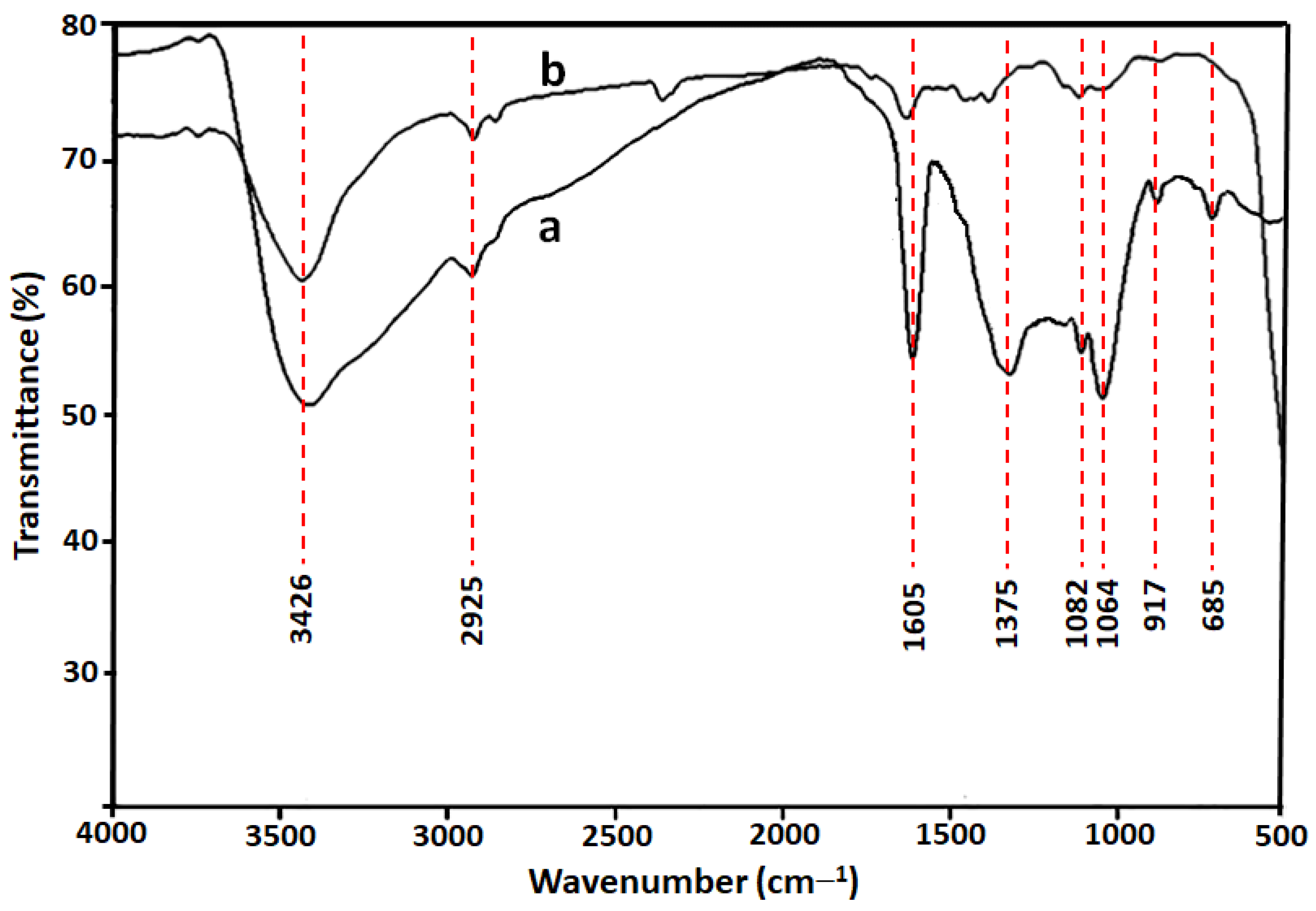
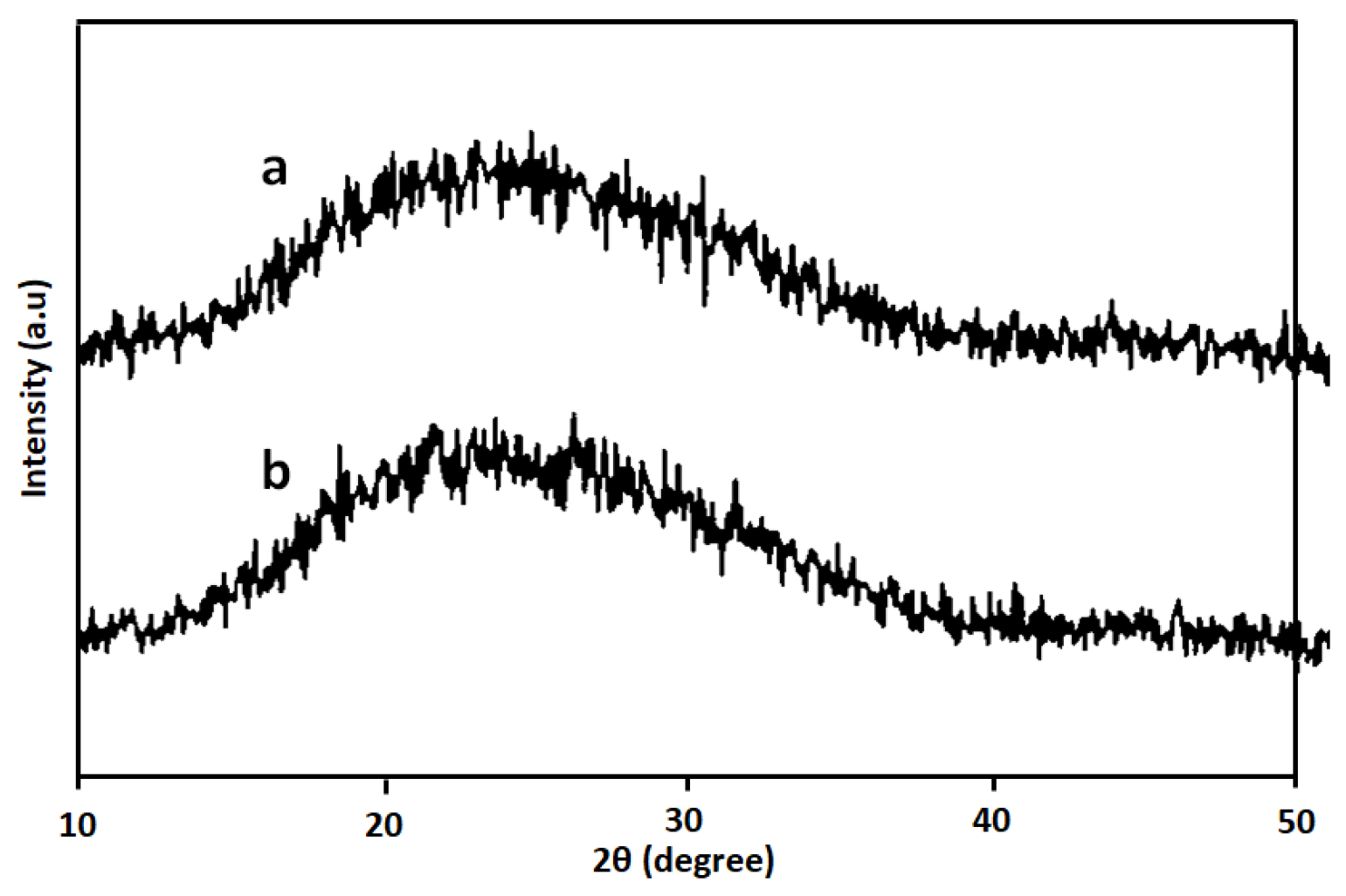

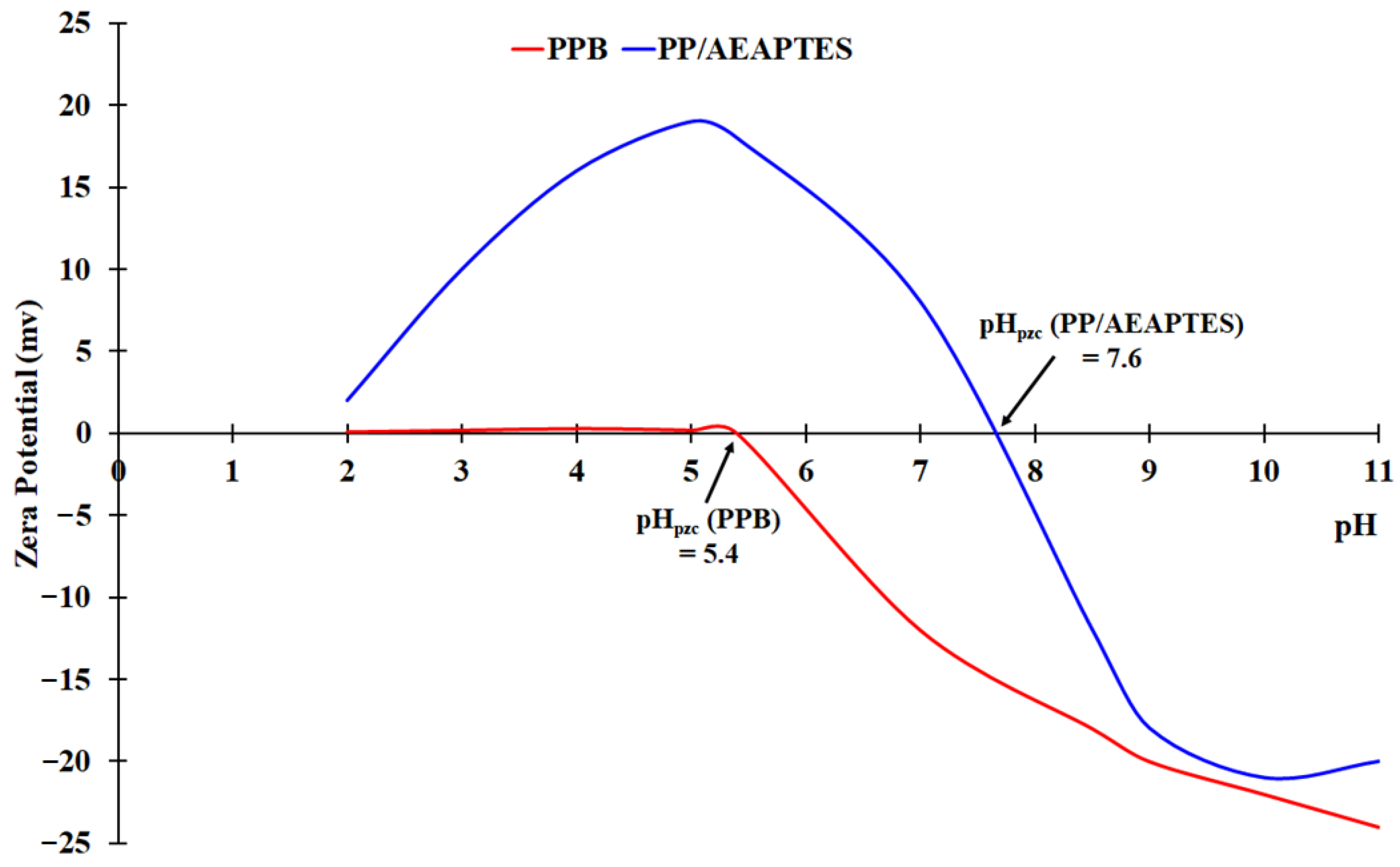

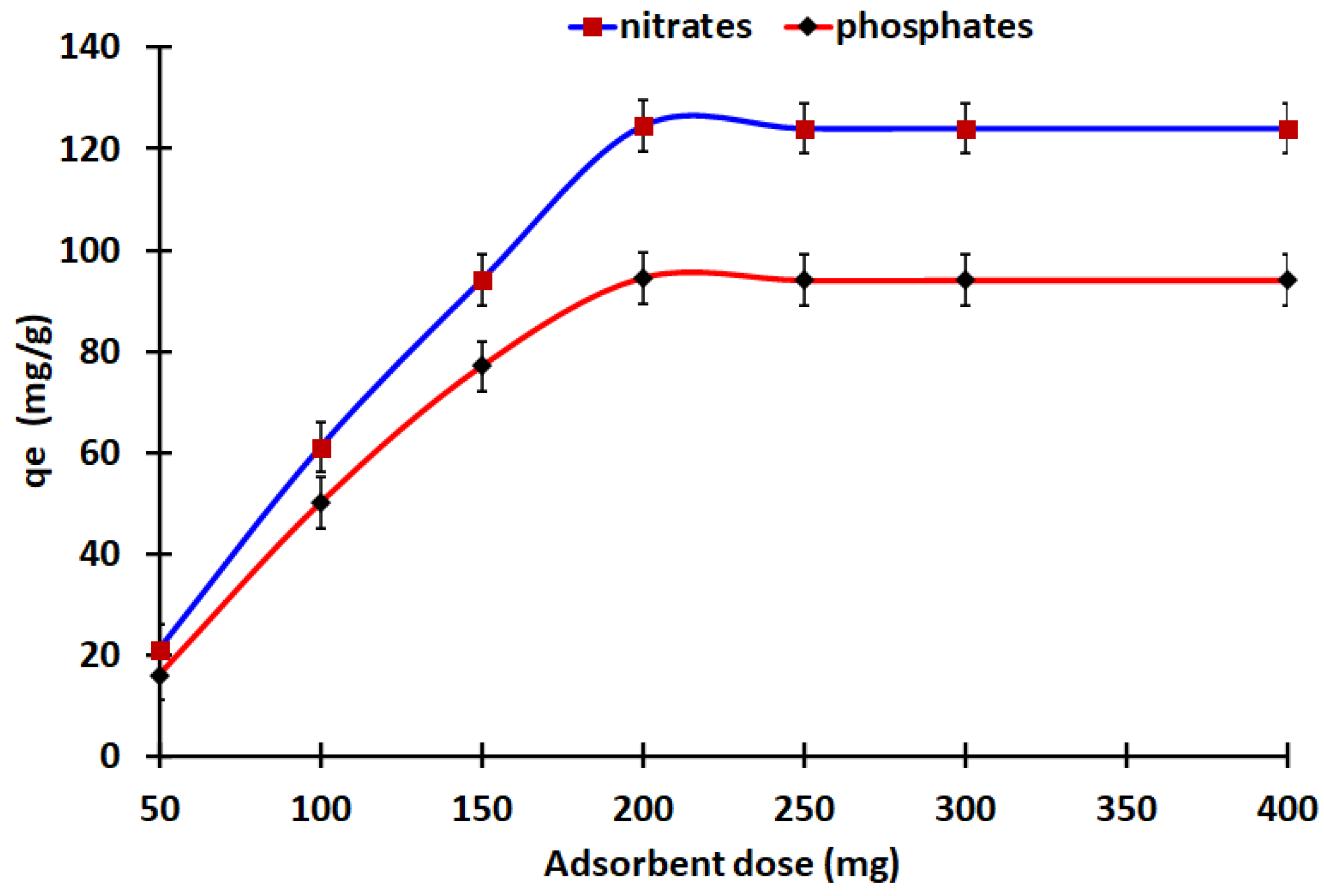
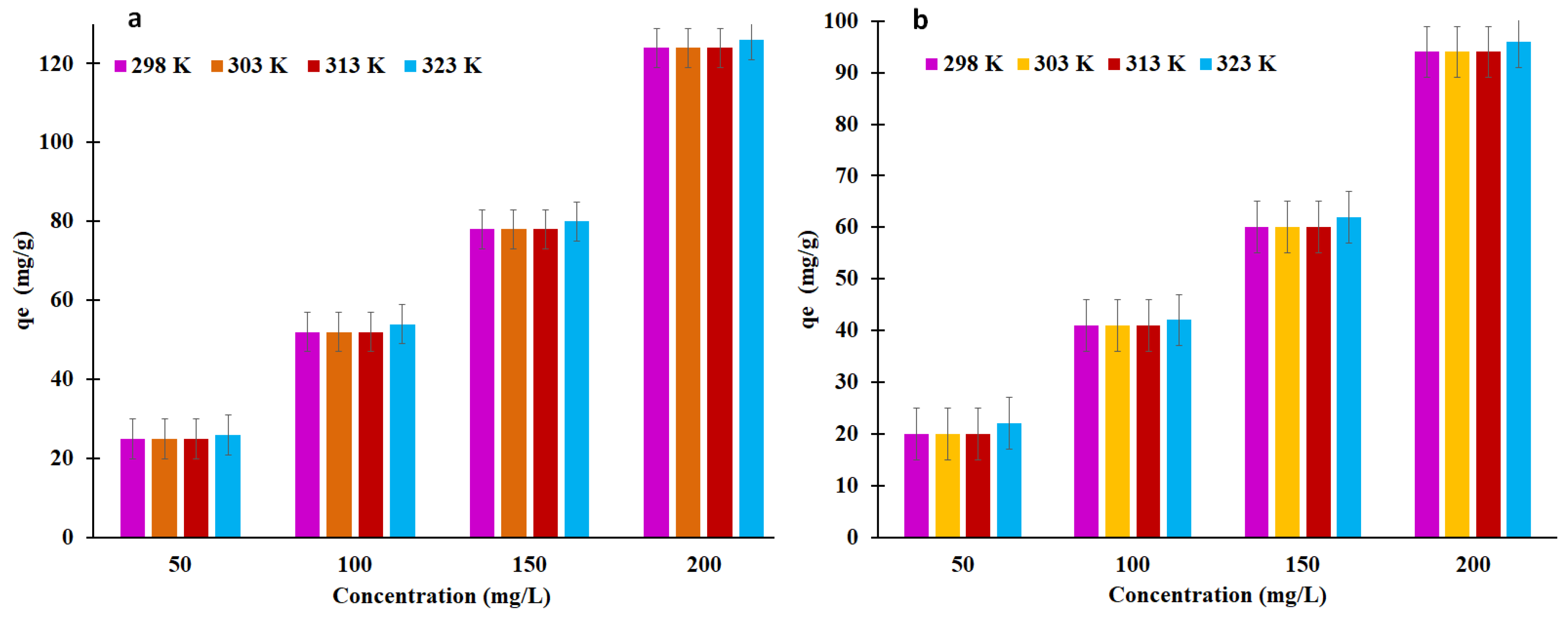


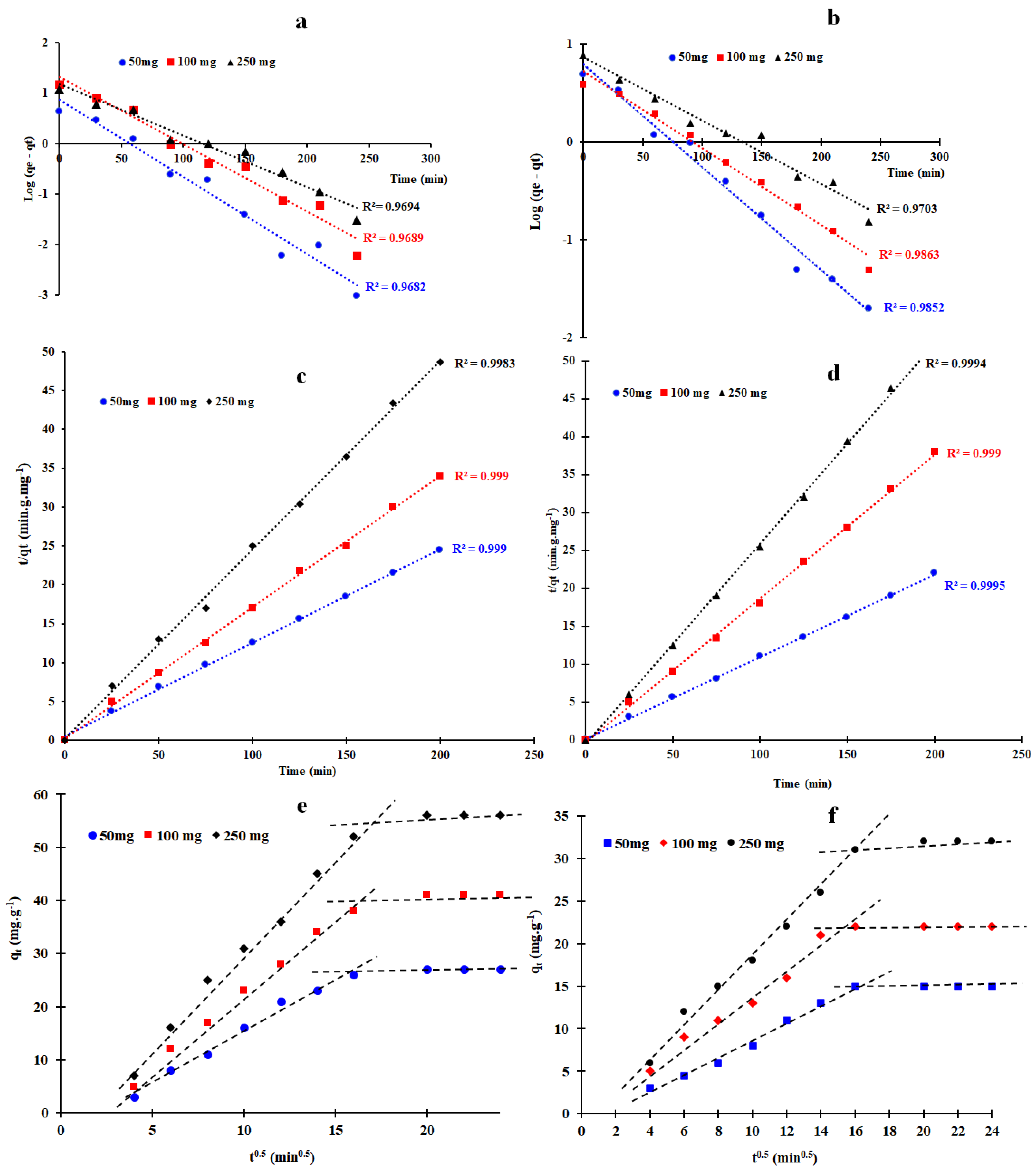
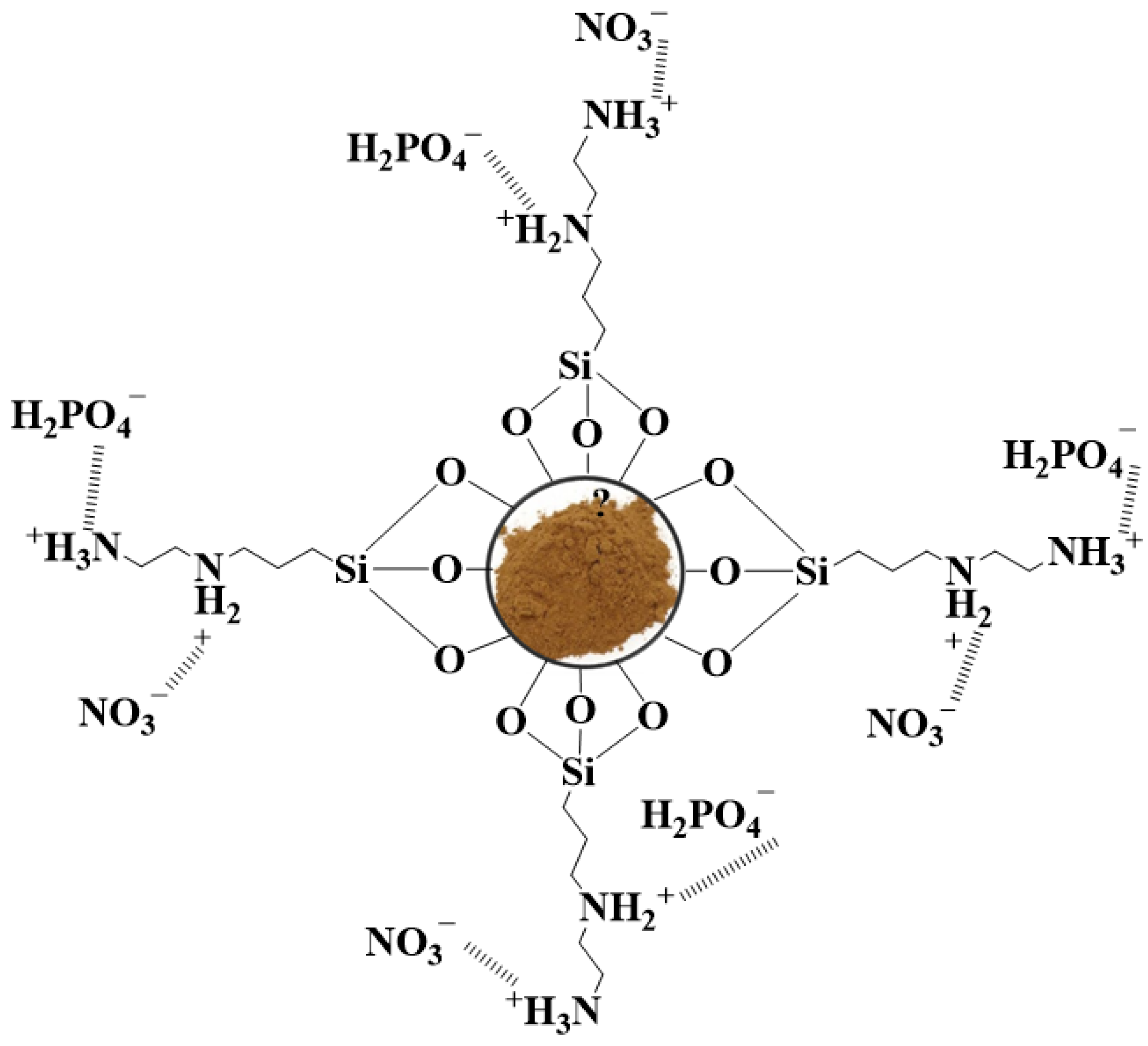

| Elements | ||||
|---|---|---|---|---|
| Samples | C1s | O1s | N1s | Si p2 |
| PPB | 75.18 | 21.85 | 2.97 | |
| PP/AEAPTES | 69.78 | 22.64 | 3.54 | 4.04 |
| Adsorbents | Adsorbate | Conditions | qe (mg g−1) | Ref. |
|---|---|---|---|---|
| Tri-alkyl-amine functionalized polystyrene | NO3− | pH 7 | 44.92 | [28] |
| Biochar-supported aluminum-substituted goethite | NO3− | pH 4–8 | 96.14 | [31] |
| Magnetite-silica-chitosan-amine nanoparticles | NO3− PO43− | pH 6 pH 5–6 | 112.5 89.95 | [36] |
| Activated carbon-supported zinc ferrite | NO3− PO43− | Acidic pH | 75.58 91.80 | [37] |
| Amine-Grafted Magnetic Chitosan (AFMCS) Composite Beads | NO3− PO43− | pH 5 pH 7 | 38.40 49.95 | [40] |
| Modified hazelnut shells with ethylenediamine | NO3− | pH 4–7 | 25.79 | [56] |
| Branched polyethyleneimine grafted onto porous rice husk silica. | PO43− | pH 4.5 | 123.46 | [57] |
| Pomegranate Peels functionalized AEAPTES | NO3− PO43− | pH 6 pH 5–6 | 124.57 94.65 | This work |
| Isotherm Models | Parameter | Value (Phosphate) | Value (Nitrate) |
|---|---|---|---|
| Langmuir | qmax (mg/g) | 93.8587 | 124.9854 |
| KL (L/mg) | 0.0748 | 0.0325 | |
| R2 | 0.9974 | 0.9986 | |
| RL | 0.19682 | 0.2941 | |
| Freundlich | KF (mg/g) (L/mg)1/n | 5.0088 | 7.5312 |
| nF | 2.6568 | 3.1248 | |
| R2 | 0.8766 | 0.9025 | |
| Temkin | KT (L/mg) | 2.6614 | 3.4296 |
| B (J/mol) | 55.7784 | 66.776 | |
| R2 | 0.8843 | 0.8987 | |
| Dubinin–Radushkevich | qs (mg/g) | 77.4684 | 112.5475 |
| KDR (mol2/J2) | 3.65·10−6 | 7.75·10−6 | |
| E (kJ/mol) | 3.1745 | 3.7025 | |
| R2 | 0.9017 | 0.9235 | |
| Sips | qm (mg g−1) | 87.2875 | 110.6284 |
| KS (L mg−1) | 0.0924 | 0.102 | |
| n | 2.2254 | 3.3875 | |
| R2 | 0.9235 | 0.9481 | |
| RMS | 11.7045 | 13.9845 |
| ΔG°(KJ/mol) | ΔH° (KJ/mol) | ΔS° (J/Kmol) | |||
|---|---|---|---|---|---|
| Anions | 203 K | 313 K | 323 K | ||
| NO3− PO43− | −4.23 −8.62 | −4.42 −9.04 | −4.81 −9.45 | −5.42 +10.91 | +40.09 +54.23 |
| NO3− | PO43− | |||||
|---|---|---|---|---|---|---|
| Concentration (mg L−1) | 50 | 100 | 250 | 50 | 100 | 250 |
| qe (exp) mg g−1 | 37 | 54 | 124 | 23 | 47 | 94 |
| Pseudo-first order | ||||||
| k1 (10−2) (min−1) | 0.0344 | 0.0302 | 0.0287 | 0.0227 | 0.0184 | 0.0152 |
| qe cal (mg g−1) | 23.245 | 37.528 | 89.5734 | 17.754 | 33.223 | 58.652 |
| R2 | 0.9785 | 0.9711 | 0.9756 | 0.9652 | 0.9702 | 0.9646 |
| Pseudo-second order | ||||||
| k2 (10−3) (g mg−1 Min−1) | 0.0192 | 0.0125 | 0.0105 | 0.0145 | 0.0096 | 0.0064 |
| qe cal (mg g−1) | 37.6587 | 54.8258 | 124.5547 | 23.5214 | 47.5324 | 94.6485 |
| R2 | 0.9996 | 0.9992 | 0.9998 | 0.9996 | 0.9995 | 0.9997 |
| Elovich | ||||||
| α (mg g−1 Min−1) | 21.3545 | 19.1254 | 49.3521 | 25.9458 | 35.5548 | 51.4355 |
| β (g mg−1) | 0.8573 | 0.6174 | 0.5877 | 0.8854 | 0.7998 | 0.8231 |
| R2 | 0.9155 | 0.9004 | 0.9354 | 0.9585 | 0.9558 | 0.9698 |
| Intra-particle diffusion | ||||||
| K1d (mg g−1 Min1/2) | 0.9777 | 1.6854 | 1.4585 | 0.5458 | 0.7725 | 0.5098 |
| C1 (mg g−1) | 28.5954 | 39.6285 | 66.0585 | 18.6369 | 32.4484 | 50.6358 |
| R12 | 0.9558 | 0.9598 | 0.9611 | 0.9712 | 0.9708 | 0.9825 |
| K2d (mg g−1 Min1/2) | 0.0367 | 0.0308 | 0.0158 | −0.0320 | −0.0034 | −0.0028 |
| C2 (mg g−1) | 36.8952 | 54.2587 | 113.7781 | 23.2585 | 46.9254 | 93.5681 |
| R22 | 0.6105 | 0.7982 | 0.7525 | 0.6998 | 0.45524 | 0.5358 |
| Parameters of the Water Quality | PP/AEAPTES | |
|---|---|---|
| Before | After | |
| pH | 5.88 | 6.12 |
| NO3− (mg/L) | 15.75 | Nil |
| PO43− (mg/L) | 20.08 | Nil |
| Cl− (mg/L) | 235.12 | 131.58 |
| SO42− (mg/L) | 168.25 | 102.55 |
| Total hardness (mg/L) | 598 | 468 |
Disclaimer/Publisher’s Note: The statements, opinions and data contained in all publications are solely those of the individual author(s) and contributor(s) and not of MDPI and/or the editor(s). MDPI and/or the editor(s) disclaim responsibility for any injury to people or property resulting from any ideas, methods, instructions or products referred to in the content. |
© 2023 by the authors. Licensee MDPI, Basel, Switzerland. This article is an open access article distributed under the terms and conditions of the Creative Commons Attribution (CC BY) license (https://creativecommons.org/licenses/by/4.0/).
Share and Cite
Abbach, W.; Laghlimi, C.; Isaad, J. Amine-Grafted Pomegranate Peels for the Simultaneous Removal of Nitrate and Phosphate Anions from Wastewater. Sustainability 2023, 15, 13991. https://doi.org/10.3390/su151813991
Abbach W, Laghlimi C, Isaad J. Amine-Grafted Pomegranate Peels for the Simultaneous Removal of Nitrate and Phosphate Anions from Wastewater. Sustainability. 2023; 15(18):13991. https://doi.org/10.3390/su151813991
Chicago/Turabian StyleAbbach, Wafae, Charaf Laghlimi, and Jalal Isaad. 2023. "Amine-Grafted Pomegranate Peels for the Simultaneous Removal of Nitrate and Phosphate Anions from Wastewater" Sustainability 15, no. 18: 13991. https://doi.org/10.3390/su151813991
APA StyleAbbach, W., Laghlimi, C., & Isaad, J. (2023). Amine-Grafted Pomegranate Peels for the Simultaneous Removal of Nitrate and Phosphate Anions from Wastewater. Sustainability, 15(18), 13991. https://doi.org/10.3390/su151813991








